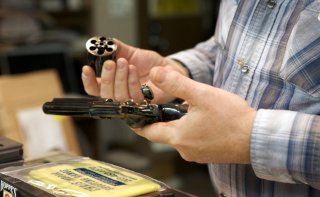How Colt Became a Global Gun Powerhouse
Its success began on February 25, 1836, when Samuel Colt was granted his first United States patent for the Colt revolver—a firearm that helped define the Old West.
Today Colt's Manufacturing Company, LLC is a subsidiary of the Czech holding company Česká zbrojovka Group (CZ), but it was the company that truly built the American firearms industry. Its success began on February 25, 1836, when Samuel Colt was granted his first United States patent for the Colt revolver—a firearm that helped define the Old West.
However, there are a couple of facts to consider. First, is that Samuel Colt didn't actually "invent" the revolver, but rather he perfected it as the Colt Paterson. Second, the company that has practically become synonymous with the frontier was first founded as the Patent Arms Manufacturing Company of Paterson, New Jersey. Like many inventors/entrepreneurs, Colt didn't see instant success. Production of his early revolver ended in 1842—but determined to give firearms design another go, Colt pressed on. That resulted in the Colt Walker, which found favor with the Texas Rangers. From that success, the Colt's Patent Fire Arms Manufacturing Company was founded in Hartford, Connecticut—and even today it remains based in New England.
Success Story
Much of Colt's success was timing. Like many inventors, he perfected a product at the time that the market most needed it. As Colt was developing and perfecting his designs, a series of major events occurred including the U.S.-Mexican War, the California Gold Rush, and the American Civil War. More importantly, Samuel Colt was also a pioneer—not just in firearms design—but in production and manufacturing. More than half a century before Henry Ford, Colt used assembly lines to mass-produce his guns, turning out as many as 150 per day.
He also built a 200-acre company town along the banks of the Connecticut River. In addition to the world's largest private armament factory, the town had parks, orchards, a railroad depot, and even a beer garden to help make his German immigrant workers (who lived in replica Swiss cottages) feel content. He introduced a ten-hour workday that included a mandated one-hour lunch break.
Colt was also a masterful marketer and self-promoter, who understood the power of advertising. He personally commissioned artist George Catlin, who was already somewhat famous for his depictions of life on the frontier, to incorporate the Colt revolvers into his paintings. Samuel Colt hired authors to pen stories that also featured the weapon, while Colt traveled the world to present heads of state with lavishly engraved, gilded pistols.
Such efforts paid off. After the Sultan of the Ottoman Empire was gifted a gold-plated revolver, the Ottoman Army placed an order for 5,000 pistols.
Known to supply both sides of a conflict in Europe; Samuel Colt had considered a similar move in America—and seeing the clouds of war on the horizon had considered opening an armory in the South. Dubbed a Southern sympathizer, Colt responded by obtaining a commission as colonel in the state of Connecticut. He never was sent into the field and was discharged less than two months later.
Samuel Colt died of complications of gout less than a year after the Civil War broke out. He was just forty-seven years old. He didn't live long enough to see the success of the Single Action Army handgun, the gun that was dubbed the "Peacemaker" and known to be "the gun that won the West." However, even with foreign ownership, the legacy of Samuel Colt lives on.

